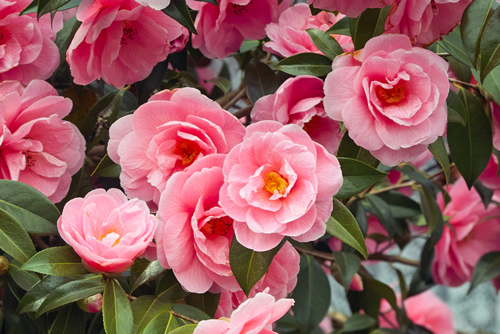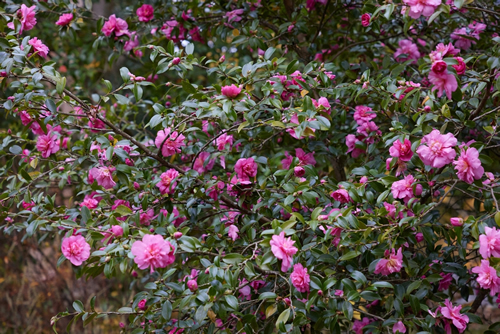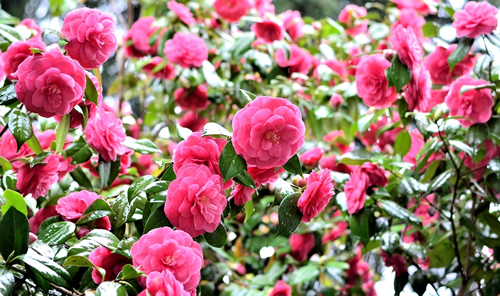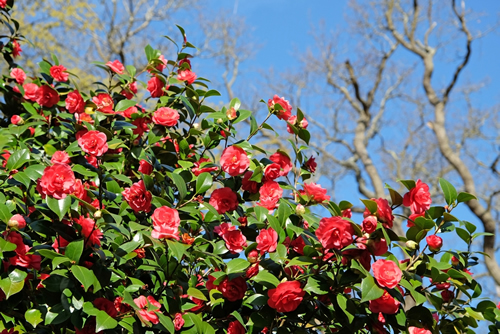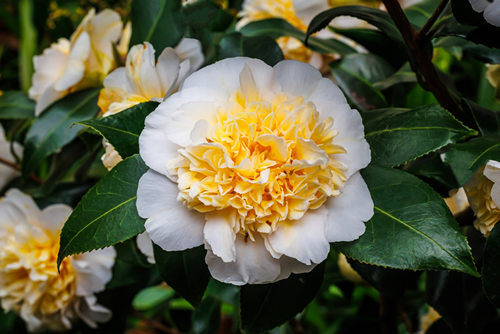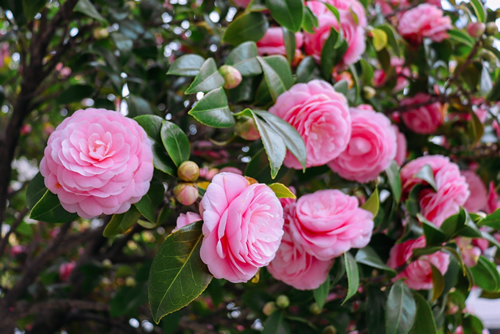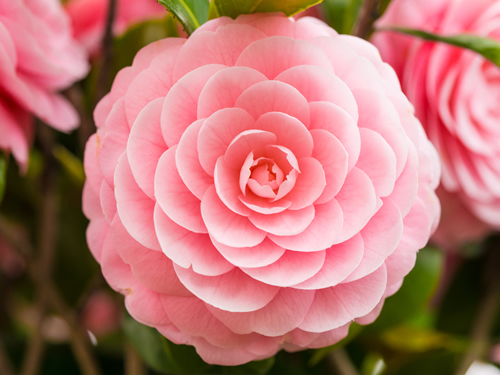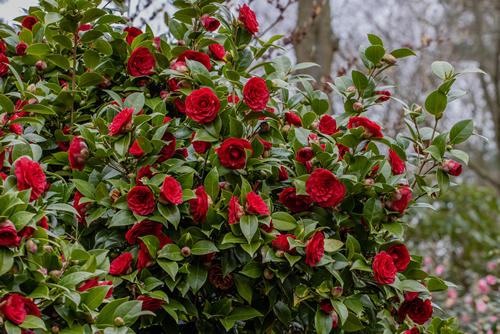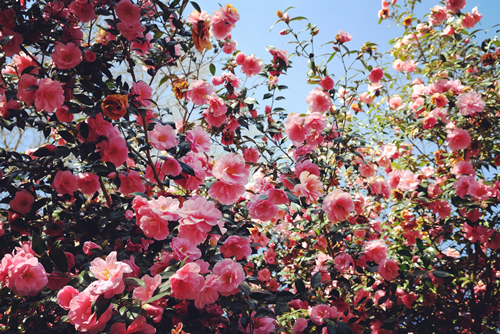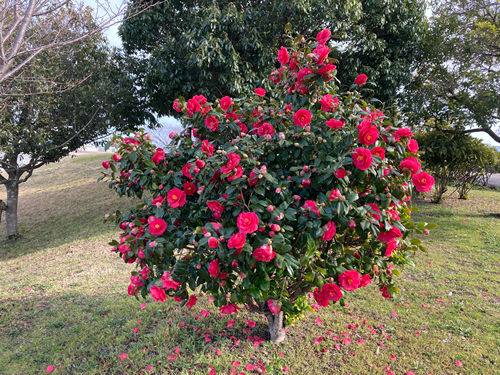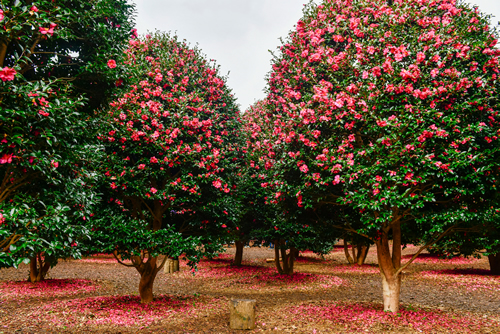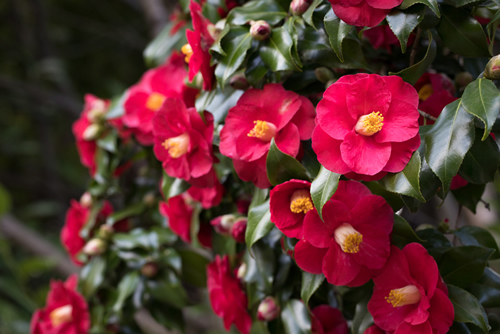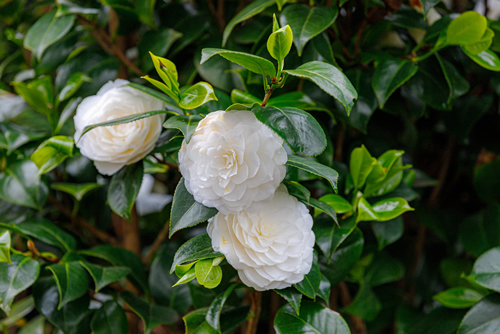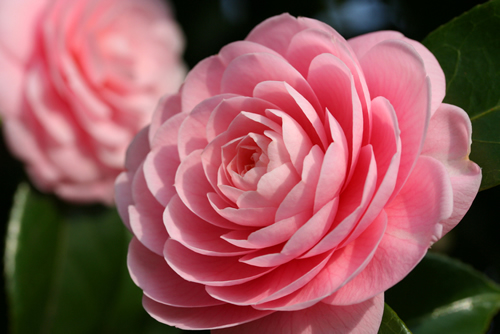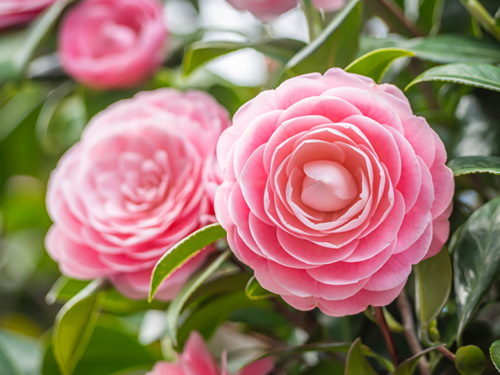How and When to Prune Camellia Shrubs in the UK
An Overview of Growing Camellia Shrubs in the UK

Camellia flowers at Jeju Camellia Arboretum, Korea
Are you a gardener living in the UK interested in understanding more about growing camellia shrubs? If so, this blog post is for you! Camellias are popular ornamental landscaping plants due to their evergreen foliage and vibrant spring blooms – they can add colour and greenery to your landscape all year round. In this article, we will provide an overview of how camellias grow in the UK, including everything from planting tips right through to looking after them throughout the seasons. Read on to discover everything you need to know about transforming your outdoor space with beautiful camellia shrubs!
Camellia shrubs are a beloved feature of many gardens in the United Kingdom. They are known for their vibrant blooms and evergreen foliage, which provide color and interest throughout the year.
Camellias thrive in part shade and prefer an ericaceous (acidic) soil, which means they can be successfully grown in all parts of the UK that do not have chalky soil. The best time to plant camellias is in the spring when you can see the flowers, or in autumn when the soil is still warm and the roots have plenty of time to establish before winter.
The vast majority of Camellias are H5 hardy in the United Kingdom, meaning they are able to survive in all but the coldest areas of the British Isles. Camellia sasanqua, known for flowering in late autumn through winter, is one particular species that is well-suited to the UK climate.
Camellias require special care at the end of summer and autumn, as they need to be well fed and watered during this time to lay down the foundation for next year's growth. When planting, the root ball should be level with the earth to prevent the plant from being planted too deeply.
Pruning should be done after flowering to maintain shape and remove any dead or damaged wood. Watering is particularly important during dry periods, and a mulch of compost or leaf mould can be added in spring to help retain soil moisture.
Camellias are impressive in shrub borders and are also ideal for containers . They can be grown more informally in light woodland beneath deciduous trees, offering a beautiful contrast. In nursery settings, camellias are often propagated by taking semi-ripe cuttings in late summer.
The History of the Camellia in the UK
For centuries, the camellia has been a popular garden flower in the United Kingdom. It is said to have arrived from East Asia in the 1700s and has since become a beloved addition to many gardens. This flowering ornamental shrub was highly prized for its bright colours, pretty blooms, and long flowering period from October to May. The name ‘camellia’ was inspired by a Czech Jesuit priest named Georg Joseph Kamel who first studied them in China. From their discovery to the present day, camellias have deepened their entrenched presence across UK gardens and homes, with British breeders now producing hundreds of varieties in an array of colour combinations.
The history of the camellia plant in the United Kingdom traces its roots back to the 18th century. The first recorded instance of a Camellia japonica growing in England was sometime before 1739 in the greenhouse of Lord Petre . This marked the beginning of what would become a long and cherished relationship between the UK and this exotic flowering plant.
Camellias were initially brought to Britain as part of the burgeoning tea trade with China. East India ships would often return with camellias on board, introducing the plant to the British environment . The camellia originates from the Far East in areas such as the eastern Himalayas, China, Japan, and Malaysia, where it usually grows in coastal and mountainous regions.
Over time, the cultivation of camellias spread across the UK. The first camellias in Britain were likely grown from seed at Thorndon Hall in Essex, the home of a wealthy horticultural enthusiast . By the Victorian era, British gardens were being transformed by plant hunters who embarked on dangerous missions to bring back exotic specimens, including camellias.
Camellias have had a significant cultural impact in the UK. They are often used in weddings and other special occasions due to their rich, vibrant blooms. Specific regions within the UK where camellias are particularly prominent include Cornwall and Devon, where the mild climate allows these delicate plants to thrive.
In terms of contributions to the country's horticulture industry, camellias have played a significant role. They have been grown in Europe since the 18th century, and their history in the East goes back centuries, even millennia. Today, camellias are one of the most treasured ornamental garden species in the UK.
The current state of camellia cultivation in the UK is flourishing. Modern cultivars of camellias are not only bred for their ornamental qualities but also for their adaptability to different climates and resistance to diseases. This has allowed them to be grown in a wider range of environments across the UK.
The future of camellias in the UK looks promising, with ongoing research and new developments in the field. For example, there is increased interest in Camellia sinensis, the species that produces tea leaves. Known for its high content of catechins, a type of flavonol, this species of camellia could potentially contribute to the UK's beverage industry.
In conclusion, the camellia plant has had a significant impact on the United Kingdom, from its initial introduction in the 18th century to its current status as a beloved garden plant. Its rich history, cultural significance, and contributions to the horticulture industry make it an important part of the UK's botanical landscape.
Recommended varieties of camellia to grow in the UK climate
Recommended varieties of camellia to grow in the UK climate Camellias are a beautiful and versatile species of flowering evergreen shrub, prized for their stunning flowers, glossy green foliage and adaptability to many climates. Most varieties of camellia are suitable for growing in the United Kingdom (UK), although some may require additional protection from harsh weather conditions. Strongly recommended are the C. japonica hybrids, many of which have been specifically bred to thrive in the UK's temperate climate. These hybrids produce large blooms in palettes varying from whites and yellows to hot pinks and oranges that are certain to provide a spectacular display when in bloom. C. sasanqua is also an excellent choice for the UK gardener; the rubescent shrub has smaller but more abundant blooms than their japonica cousins and typically flower a few weeks earlier. Finally, C. x williamsii hybrids make an ideal addition to any UK garden; they boast unique colors including deep coral-reds - all while requiring relatively low levels of maintenance throughout the season. All three of these varieties will reward any UK gardener with year-round beauty and vibrancy!
There are many varieties of Camellia shrubs which are best grown in the UK. Here is a list of some of the recommended varieties:
- Camellia japonica – This popular evergreen shrub has glossy, dark green foliage and produces large, bright pink to white flowers with yellow stamens in late winter or early spring.
- Camellia sasanqua – This variety may be deciduous or semi-evergreen and produces fragrant, small white to pink flowers with yellow centers in late fall or early winter.
- Camellia oleifera – This evergreen shrub can handle cold temperatures better than most other varieties, and has white to pink cup-shaped flowers with yellow and red stamens that bloom in late spring or early summer.
- Camellia reticulata – This variety has wide, glossy leaves that turn reddish-brown in the fall, and produces large, frilly pink to purple blooms with yellow anthers from midwinter through late spring.
- Camellia × williamsii – This hybrid shrub is an easy-care evergreen variety that bears salmon-colored blossoms with deep red markings from late winter into spring.
Camellia sasanqua
Camellia sasanqua, also known as the Christmas or Yuletide camellia due to its winter blooming period, is a popular choice for many gardeners in the UK.
Originating from Japan, Camellia sasanqua is a species of Camellia that is known for its glossy, evergreen leaves and stunning, fragrant flowers. It is a medium-sized shrub that typically grows 1.5-2.5 meters tall .
In terms of growth habits, Camellia sasanqua prefers a slightly acidic, well-drained soil and semi-shaded position. It is more sun-tolerant and less formal in appearance than Camellia japonica, making it a versatile choice for a variety of garden styles .
The preferred climate for planting Camellia sasanqua is temperate to subtropical, meaning it is well-suited to much of the UK's climate. However, it may struggle in extremely cold areas or in soils with a high pH (alkaline soils).
Advantages of Growing Camellia sasanqua in the UK
One of the primary advantages of growing Camellia sasanqua in the UK is its bloom period. Unlike most camellias, which bloom in spring, Camellia sasanqua flowers from late autumn to early winter, providing color and interest during a time when many other plants are dormant .
In terms of color variety, Camellia sasanqua offers a stunning array of options, from pure white to deep pink and everything in between. This, combined with its ease of care and adaptability to British weather conditions, make it a popular choice for UK gardeners.
Camellia sasanqua thrives particularly well in regions like Cornwall and Devon, where the mild climate allows it to flourish. However, with the right care, it can be successfully grown in many parts of the UK.
Caring for Camellia sasanqua
To ensure the health and longevity of Camellia sasanqua, there are a few key care tips to keep in mind. First, avoid planting in areas where early morning sun will hit the plant, as this can cause frost damage to the flowers .
Camellias prefer a moist but well-drained soil, so water regularly, especially during dry periods. Mulching in spring can help retain soil moisture and suppress weeds.
Pruning should be done after flowering to maintain shape and remove any dead or damaged wood. Avoid heavy pruning as this can lead to a sparse and leggy appearance .
In conclusion, Camellia sasanqua is a versatile and beautiful addition to many UK gardens. With the correct care and conditions, it can provide a stunning display of color during the winter months.
Choosing the right soil and location for successful planting
When planning to plant, it is important to consider the type of soil you will be using along with the area's climate. Different plants may require sandy or clay-like soils, while some species can tolerate more acidic or alkaline soils. Additionally, different climates will have specific temperatures, wind speeds and amount of precipitation that can influence how well a certain species grows. Therefore, it is wise to do research first on which types of plants might flourish in the given environment. Once you have found a few suitable plants for your space and soil, it is also important to give careful consideration to where in the garden they should be placed. Evaluate where there might be more sun or shade during different times of day as this can impact how much a plant will grow. Ultimately, taking time to select the ideal soil and locale can make all the difference in determining whether your plants thrive or not!
Camellias are some of the hardiest flowering shrubs, and can tolerate cold temperatures down to -5⁰C (23⁰F). However, Some varieties, such as Camellia oleifera, can survive temperatures as low as -10⁰C (14⁰F). It is important to note that young plants should be protected from frost and windy weather.
Important tips for preparing your soil before planting
Preparing your soil before you begin planting is essential for a successful garden. Start by making sure the area in which you are planning to plant is weed-free and clear of any debris. Then, add organic matter such as compost or aged manure to create a nutrient-rich environment that will encourage healthy plant growth. When tilling, mix the organic matter into the top 6–8 inches of soil with a rake or shovel, to ensure it reaches deep down into the roots. It is also important to consider testing pH levels of the soil and consider adding amendments based on results from the test. Adding fertilizer before planting can further enrich the soil and make it more conducive for growth. By following these steps, you will better set your garden up for success!
How to Grow the Camellia Shrubs from Seed
Growing camellia shrubs from seed is a fulfilling task that requires patience and effort. You will need to start the process by first gathering healthy camellia seeds, which can be collected from plants that are in bloom. Then, you should place the seeds in water or moist peat moss and keep them in a shaded area until they germinate. Once tiny roots have sprouted, you will need to carefully transplant them into larger containers with soil and compost mix. Keeping the plants well-drained and watered at regular intervals is important for promoting growth, as is ensuring that they get adequate sunlight each day. With some care and attention, those Camellia shrubs will soon begin blossoming!
Growing camellia bushes from seed is a rewarding process that will reward you with years of beautiful blooms. Here is a step-by-step guide on how to grow camellia shrubs from seed:
- Start by purchasing fresh camellia seeds, either online or from a local nursery. It’s important to choose seeds that are still in their shells, as these will provide the best results.
- Soak the seeds overnight in warm water to soften their shells. This process may take up to 24 hours so plan accordingly.
- After soaking, sow the seeds in soil mix and cover lightly with more soil mix before spraying the surface gently with water to keep it moist.
- Place your seed trays in an area where they will receive plenty of indirect sunlight and keep the soil moist but not soggy at all times. Note: If you live in a warmer climate, you may need to protect your seedlings from midday sun as too much heat can burn them.
- When your seedlings reach three inches in height, begin fertilizing them every two weeks with an organic fertilizer meant for Camellias and follow directions on packaging for application rates and frequency of use.
- Depending on where you live, once your plants are about one foot tall you can move them outdoors into their permanent home if desired; however, be sure to check weather patterns first as cold drafts or frost can harm young Camellias until they are established enough to handle harsher weather conditions such extreme temperatures bring about..
With regular care and attention come cycles of stunning blooms each season; however, it’s important to maintain proper watering practices (deep watering twice per week) along with pruning dead or dying branches during winter when bush growth has slowed down considerably so new shoots have plenty of room come spring time!
How to Propagate the Camellia Shrubs
Propagating Camellia shrubs at home is a rewarding experience that is made easier with the right knowledge and tools. First, you will need to start small by gathering well-developed cuttings from healthy Camellia shrubs. Then, find a sunny garden bed or pot that contains high quality soil that drains well and contains fertilizer. Next, you will want to ensure adequate water availability for your cuttings to be successful. Finally, cover your cuttings in sand and wait for the first shoots of leaves to emerge in a few weeks or months before uprooting and transplanting them into your desired location. With patience, perseverance, and proper care your home propagated Camellias should thrive and reward you with beautiful flowers.
Propagating camellia shrubs is a great way to create more of these beautiful plants that you can share with friends, family, and your local community! Here is a step-by-step guide on how to propagate camellia shrubs:
- Start by preparing the desired cutting. Choose healthy looking shoots that are free from disease and insects and cut at a 45 degree angle just below a leaf node. Remove any flowers or buds from the cutting if present and shorten the remaining stems so they are no longer than six inches long.
- Fill small pots with fresh potting soil that contains organic material such as peat moss or compost to ensure optimal drainage and aeration for the roots.
- Create a hole in each pot with your finger, insert the cutting and cover it with soil before lightly patting down the surface of the soil around it. Gently press down on each cutting until secure before spraying with water to keep it moist but not too wet or saturated as this can create anaerobic conditions which can cause Root Rot or other plant diseases/pests fungal growths.
- Place your pots in bright indirect light, such as near an east-facing window, and make sure to check on them every few days during their growing period to make sure they’re getting enough moisture but not too much (or too little).
- Once your cuttings have taken root - i.e., shown signs of new growth after 3-4 weeks - you can begin fertilizing them every two weeks using an organic fertilizer intended for Camellias according to instructions on packaging for application rates and frequency of use.
- After about 8-10 weeks your camellia shrubs should be ready for planting outdoors; however, depending on where you live be sure to check weather patterns first as cold drafts or frost can harm young Camellias until they are established enough to handle harsher weather conditions such extreme temperatures bring about..
- Finally, don’t forget regular care once your new bush is in its permanent home – this includes deep watering twice per week along with pruning dead or dying branches during winter when bush growth has slowed down considerably so new shoots have plenty of room come spring time!
In conclusion, camellia shrubs provide a stunning display of blooms throughout the spring and winter months, adding vibrant colour and structure to any garden. By selecting the right varieties that work with your climate, planting them in well-draining soil and in the right location, and then caring for them regularly, you can be sure to enjoy beautiful blooms year after year. Additionally, if you are looking to mix it up, there is always the option of growing camellias from seed or propagating your own cuttings. So why not add beauty to your backyard this season by introducing some quintessentially British camellia shrubs into your landscaping? The results will be breathtaking – as they have been for centuries!
The best times to plant and how to care for your camellia shrubs
Planting and caring for camellia shrubs can be a rewarding experience if you know the right timing and techniques. The best times for planting new camellia shrubs are typically in spring or fall – these seasons provide an optimum soil temperature that allows the root system to rapidly establish itself. For optimal growth, make sure to give your shrubs an ample amount of mulch and water regularly. Be aware of common diseases such as Camellia petal blight and scale; inspect plants, and if necessary, spray with fungicide to protect them throughout the year. With appropriate care and attention, you will have fabulously blooming camellia shrubs all year round!
Where is the best place to plant camellia?
The ideal place to plant camellias is in an area with partial shade, especially during the warmer months when temperatures are higher. Camellias need fertile, well-drained soil with plenty of organic matter. Mulch can be used to help keep the roots cool and moist. Planting near larger trees or shrubs can provide additional protection against excessively hot weather since the additional shade helps lower temperatures overall. For optimal growth and success, provide a consistent level of water so the soil remains consistently moist. Additionally, it's important to prune camellia plants that have been recently transplanted until they become re-established into their new environment. With these conditions in mind, gardeners should find that planting camellias is a delightful way to add beauty and fragrance to any outdoor location.
Are camellias best in pots or ground?
The question of whether camellias are best in pots or in the ground largely depends on the growing conditions and personal preference. Growing camellias in the ground allows them to benefit from natural air and soil temperatures, as well as from additional water sources that may be present. This can help them thrive over a longer period of time with less care. However, potting up a camellia allows for an easier control of its environment, providing ultimate flexibility for its caretaker. For example, if your climate experiences chilly winter temperatures, potted camellias can easily be moved indoors or into a warm greenhouse; conversely, if extreme heat or drought is a concern during summer months, pots can also be moved to areas receiving more shade. Ultimately, deciding whether to grow camellias in pots or directly in the ground is best determined by analyzing your local climate and specific care requirements.
How big do camellias grow?
Camellias are an evergreen shrub or small tree that can grow to be quite tall, with some species reaching a height of over 20 feet. They are also noted for their long-lasting, showy flowers and glossy green leaves. Generally speaking, most camellia varieties grow between 8-12 feet tall and wide, although they can produce more significant growth in more favorable climates. Some shrubs remain much smaller, on closer to 4 feet tall, while hedge varieties often grow higher than 12 feet when planted distances as close as 3 to 4 inches apart.
Do camellias like full sun or shade?
Camellias are beloved shrubs that thrive in part sun and shade. Unlike many other flowering shrubs, which typically require full sun in order to support lush blooms and long-lasting growth, camellias perform best with 4 or 5 hours of direct sunlight each day. This can come from either the morning or afternoon sun, or a combination of both. If a camellia is exposed to too much full sun for extended periods of time, it can become stressed and be more susceptible to disease. On the other hand, planting ample amounts of camellia control can lead to beautiful, abundant blooms when the weather warms up during later winter months.
How to Grow and Care for Camellia
Camellia plants are an ideal addition to any home or garden, as they offer year-round interest with their fragrant blooms, glossy dark green leaves, and delicate branches. To ensure your plants grow in the best way possible, make sure to place them in a sunny spot sheltered from strong winds. They also enjoy rich, moist soil and regular watering; however be careful not to overwater as this can cause Root Rot. Additionally, camellias appreciate an occasional feeding with a good quality fertilizer - either liquid or granular will work. For peak bloom potential and plant health, comellias should be pruned after flowering by cutting off any dead or diseased stems. With minimal effort and some TLC, camellias will thrive for many years providing lasting enjoyment for the whole family.
Common issues with growing camellias and how to fix them
Camellia plants are often admired for their beautiful flowers, making them a popular choice in the garden. However, these delicate plants can be affected by various issues like pests, diseases, poor watering and soil problems that, if left unchecked, can stunt growth. The key to ensuring your camellias remain healthy is to be aware of the most common issues and take steps to prevent them occurring. This may include choosing the best potting mix for acid-loving plants - such as one with high organic matter content - vigilant monitoring of pests and diseases, maintaining adequate humidity for indoor plants and providing sufficient water during hot weather. By taking these proactive measures you'll have healthier camellia plants that will put on spectacular displays of colour throughout their blooming period.
Camellia shrubs can be affected by a variety of pests, including mealybugs, Aphids, scale insects, caterpillars, mites and Thrips. Here is a brief overview of each pest:
- Mealybugs – These small white pests suck the sap out of camellia bushes and can cause leaves to yellow and drop prematurely. They are usually found in clusters on the underside of the foliage or at the base of stems.
- Aphids – These tiny green insects are commonly found on camellia bushes, where they suck sap from the young leaves and buds. This can cause wilting and yellowing of the foliage, as well as distorted growth.
- scale insects – scale insects are small brown or grey bugs that feed on plant sap. They form white or brown bumps along branches and stems and eventually cause leaf drop if left unchecked.
- Caterpillars – Caterpillars feed voraciously on new growth such as buds and young leaves, causing them to become malformed or to completely drop off altogether.
- Spider Mites – Mites are very small spiders that spin webs over maturing foliage which then turns yellow or bronze in color. They also secrete an oily substance which causes further damage to the plant's health.
- Thrips – Thrips are very small flying insects that deposit eggs into flowers, buds or stems; these eggs hatch quickly into larvae which feed on petals and cause them to deform or discolor.
Camellia shrubs are susceptible to a number of fungal and bacterial diseases. Here is a brief overview of each disease:
- Fungal Leaf Spot – This fungal disease causes circular Black Spots on the leaves or stems of camellia plants. The spots can eventually expand and cause the foliage to turn yellow and curl before eventually falling off.
- Root Rot – Root Rot is caused by overwatering, poor drainage or contaminated soil, and can cause the roots of camellia shrubs to turn soft and dark in color. It can also lead to stunted growth, yellowing of the leaves and eventual death if left unchecked.
- Camellia Petal Blight – This fungus causes dark spots on petals which then become covered in white spores; left unchecked, it can spread rapidly throughout the bush causing flowers to be discolored or distorted in shape.
- Powdery Mildew – Powdery Mildew is caused by excessive humidity or wet weather, and appears as white powdery patches on both sides of leaves. If left untreated it can cause foliage to yellow, wilt and die prematurely.
- Bacterial Leaf Spot – This bacterial disease infects camellia bushes through wounds or insect infestations and manifests as small reddish-brown spots on the leaves which eventually turn black with a purple halo around them. Overtime this will cause the foliage to drop prematurely from the bush, leading to weaker blooms in springtime.
How to Prune Camellia Shrubs
Camellia shrubs are an ideal addition to any garden, offering year-round beauty with the right care and maintenance. Pruning is one of the most important parts of caring for camellias; it not only encourages new growth and blossoms, but can also help keep them healthy over time. Knowing how to properly prune your camellia bush will help ensure it maintains its vibrant beauty as part of your outdoor oasis. In this blog post, you’ll find out why pruning camellias is so critical along with step-by-step instructions on how to do it correctly!
Understand the Pruning Process
– Why prune and when to prune camellia shrubs. Pruning camellia shrubs can be a beneficial and rewarding task for gardeners. When done at the correct times of the year, pruning can help shape or maintain a specific height and overall look of your shrubs. Additionally, it can remove some of the dead wood from the plant that could interfere with new growth or promote diseases. Pruning should generally occur in springtime before new growth starts, typically when temperatures rise above 10 degrees Celsius on multiple consecutive days. Pruned properly, camellias provide you with a lush array of bright flowers every springtime season; making it a worthwhile yearly task to take on. Despite this, it is important to know that if heavy pruning occurs too late in the year, for instance after summer has arrived into full bloom - then flower production may suffer during the following season due to delayed blooming times occurring later in years to follow. Therefore, understanding why and when you should prune your shrub is essential to reaping its long term rewards.
Prepare for Pruning
– Tools required and safety considerations. Before starting any pruning project, it's important to make sure you have the right equipment and know the necessary safety precautions. The basic tools you'll need are a pair of sharp pruning shears or loppers, and if your plants are tall, you may also want to use a ladder. For safety reasons, be sure to check that your ladders or other equipment used for pruning do not have loose screws or nuts and bolts. When using these tools, also remember to wear proper protective clothing such as gloves and eye protection. Remember that this is hard labor; taking frequent breaks can help reduce fatigue and prevent injury from overexertion. Pruning is a test of patience so always take the time to plan out your steps and create a clear strategy - think about how you should start and progress through each cutting session. By preparing ahead of time with the right gear, taking the necessary safety measures, and learning patience, you will be well equipped for any pruning project!
Cut Out Dead or Damaged Branches
- Removing dead or damaged branches is important to maintain healthy growth and blooms of your camellia shrub.
Pruning is an important part of the maintenance process for camellias, and it's essential to cut out any dead or damaged branches. Removing these unhealthy parts of the shrub will make way for healthier growth and more vibrant blooms. As you begin pruning, identify any weak or damaged branches first, as these are often harboring pests or infections that can be spread if they remain in contact with healthy sections of the plant. Cutting off dead and diseased material will help reduce the chance of these problems spreading and allow your shrub to grow healthily and produce bright blossoms each spring.
Trim the Shrub’s Healthy Branches
- Learn the right way to prune your camellia shrub to ensure maximum health and growth.
Pruning your camellia shrub correctly is essential if you want it to reach its full potential and continue growing healthy branches. There are a few basic pruning techniques that you should take into consideration when trimming away dead or excess foliage, such as cutting at the right angle and removing selective shoots in even numbers. To ensure maximum health and growth of the shrub, make sure you always use sharpened pruning shears when cutting branches and follow the natural crown shape of the plant rather than severely altering its form by removing too much foliage. Taking these steps will help keep your camellia shrub lush and healthy for years to come.
Pruning camellia shrubs is an important part of maintaining healthy plants and ensuring beautiful blooms for years to come. Here is a comprehensive step-by-step guide on how to properly prune camellia shrubs:
- Start by identifying dead or diseased branches that need to be removed as these can weaken the plant if left untreated. It’s also recommended to remove any overcrowded shoots that are growing too close together in order to improve air circulation and promote healthy growth.
- Use sharp pruning shears or loppers when cutting away branches (avoid using blades, as these may pinch delicate stems) and make sure all cuts are clean at 45 degree angles just below the point where the branch joins with another stem.
- Once you finish pruning, it’s important to check the bush for any signs of pests or disease so that it can be treated promptly if needed; this may involve using insecticidal soap or neem oil (check packaging instructions). Additionally, inspect your shrub for any broken branches or stems and remove them as well if you find any.
- After cleaning up the bush, apply fertilizer intended for camellias according to package instructions – usually per month during its growing season – in order to promote new growth and keep your plants healthy!
- You should also mulch around the base of your camellia bush with organic matter such as bark chips or compost in order to keep the soil moist and reduce weeds; this will also help insulate root systems from frost during winter months when temperatures drop dangerously low in some areas..
- Finally, never forget regular deep watering twice per week during hot months as this helps keep Camellias hydrated and happy!
Enjoy Your Pruned Camellia Shrub
– Tips on how to best enjoy your new, fresh-looking camellia shrub!
Pruning a camellia shrub can give it a fresh, revived look and help it to flourish even more. After your shrub has been pruned, you can enjoy the many benefits it brings. To begin with, pruning your camellia shrub encourages healthy growth by promoting new and better branches and flowers. Furthermore, it contributes to better air circulation around the plant which leads to strong stems. Finally, pruning is necessary for improved coloration on flowers allowing them to really stand out in your garden or in a pot. With this knowledge, you'll be able to appreciate your newly pruned camellia shrub even more and make sure it continues to look its best every day.
How To Maintain Your Pruned Camellia Shrub
- Knowledge on how to keep up with maintenance and pruning of your pruned camellia shrub for a long life.
The pruning of camellia shrubs is essential for keeping the plant in optimal health and looking its best. In order to maintain your pruned camellia shrub, it is important to water it regularly and use a mulch to keep the moisture in. Regular fertilizing with an acid-based fertilizer also supports growth by providing necessary nutrients for the plant. Most importantly, though, your pruned camellia shrub should be trimmed every few weeks during its active growing season to keep its shape and promote new buds on existing branches. Prune away dead and damaged branches as soon as you notice them and remove any suckers coming up from the base to ensure that your shrub remains healthy. With proper care, your pruned camellia will provide years of flowers and flourish in whatever outdoor space you choose.
Pruning camellia shrubs, or any plant for that matter, is a rewarding experience and comes with many great benefits. Not only can you enjoy the beauty of seeing new blooms on your pruned shrub, but you are also able to maintain the health and growth of your plants by removing any old, dead, or damaged branches. Having a basic understanding of why prune and when to prune, plus having the proper safety equipment and right cutting techniques can aid in ensuring that you get the most out of your pruned camellia shrub. Follow through with maintenance pruning as needed and watch your carefully-selected camellia variety thrive! For a successful outcome when it comes to pruning camellias, remember: be conscious of why you are doing it and be sure to stick within the guidelines for healthy growth!
How to Prune Climbing Vines
List by Variety
- How to Prune Actinidia
- How to Prune Akebia
- How to Prune Bougainvillea
- How to Prune Campsis
- How to Prune Celastrus
- How to Prune Chilean Glory Vine
- How to Prune Clematis Armandii
- How to Prune Clematis Montana
- How to Prune Climbing Rose
- How to Prune Hedera GoldHeart
- How to Prune Honeysuckle
- How to Prune Hydrangea Petiolaris
- How to Prune Ivy
- How to Prune Japanese Wisteria
- How to Prune Morning Glory
- How to Prune Parthenocissus
- How to Prune Persian Ivy Hedera Colchica
- How to Prune Schisandra
- How to Prune Star Jasmine
- How to Prune Sweet Peas
- How to Prune True Jasmine
- How to Prune Virginia Creeper
- How to Prune Wisteria
How to Prune Hedges
List by Variety
- How to Prune an Arborvitae Hedge
- How to Prune a Barberry Hedge
- How to Prune a Beech Hedge
- How to Prune a Boxwood Hedge
- How to Prune a Butterfly Bush Hedge
- How to Prune a Cotoneaster Hedge
- How to Prune an English Lavender Hedge
- How to Prune an Escallonia Hedge
- How to Prune an Euonymus-Hedge
- How to Prune a Firethorn Hedge
- How to Prune a Forsythia Hedge
- How to Prune a Griselinia Hedge
- How to Prune a Hawthorn Hedge
- How to Prune a Holly Hedge
- How to Prune a Hornbeam Hedge
- How to Prune a Laurel Hedge
- How to Prune a Leylandii Hedge
- How to Prune a Lilac Hedge
- How to Prune a Maple Leaf Viburnum Hedge
- How to Prune a Photinia Hedge
- How to Prune a Pink Ramanus Rose Hedge
- How to Prune a Privet Hedge
- How to Prune a Pyracantha Hedge
- How to Prune a Spirea Hedge
- How to Prune a Thuja Hedge
- How to Prune a Viburnum Hedge
- How to Prune a Western Red Cedar Hedge
- How to Prune a Yew Hedge
How to Prune Shrubs
List by Variety
- How to Prune an Abelia Shrub
- How to Prune an Abutilon
- How to Prune an Acer / Japanese-Maple
- How to Prune an Amelanchiers
- How to Prune an Apple-Tree
- How to Prune an Arbovitae Shrub
- How to Prune an Arbutus
- How to Prune an Aucuba
- How to Prune a Azalea Mollis
- How to Prune Azaleas
- How to Prune a Bay Tree Shrub
- How to Prune a Berberis Darwinii
- How to Prune Berberis Deciduous Types
- How to Prune a Boxwood Shrubs
- How to Prune a Brachyglottis Senecio
- How to Prune a Buddleia Alternifolia
- How to Prune Buddleias Butterfly Bushes
- How to Prune a Buddleja Globosa
- How to Prune a Callicarpa
- How to Prune a Camellia
- How to Prune a Caryopteris
- How to Prune a Catalpa Bignonioides Aurea
- How to Prune Ceanothus Deciduous Types
- How to Prune Ceanothus Evergreen Types
- How to Prune a Ceratostigma
- How to Prune a Chaenomeles
- How to Prune a Choisya
- How to Prune a Cistus
- How to Prune a Clematis
- How to Prune a Cornus
- How to Prune a Cotinus Royal Purple
- How to Prune a Cytisus Scoparius
- How to Prune a Exochorda x Macrantha
- How to Prune a Forsythia
- How to Prune a Hebe
- How to Prune a Hydrangeas
- How to Prune Juniper Shrubs
- How to Prune a Lavatera
- How to Prune Lilac Bushes
- How to Prune a Mugo Pine
- How to Prune Rose Bushes
- How to Prune Spirea Shrubs
- How to Prune Viburnum Shrubs
- How to Prune a Weigela
- How to Prune a Yew
How to Prune Trees
List by Variety
- How to Prune a Apple Tree
- How to Prune a Apricot Tree
- How to Prune a Ash Tree
- How to Prune a Birch Tree
- How to Prune a Cherry Tree
- How to Prune a Elm Tree
- How to Prune a Fig Tree
- How to Prune a Grape Tree
- How to Prune a Hickory Tree
- How to Prune a Maple Tree
- How to Prune a Oak Tree
- How to Prune an Olive Tree
- How to Prune a Peach Tree
- How to Prune a Pear Tree
- How to Prune a Plum Tree
- How to Prune a Poplar Tree
- How to Prune a Walnut Tree
Pests and Diseases
- How to Protect from Anthracnose
- How to Protect from Athids
- How to Protect from Apple Scab
- How to Protect from Armillaria Root Rot
- How to Protect from Bagworms
- How to Protect from Black Knot
- How to Protect from Black Rot
- How to Protect from Black Spot
- How to Protect from Botryosphaeria Dieback
- How to Protect from Botrytis Blight
- How to Protect from Brown Rot
- How to Protect from Canker Diseases
- How to Protect from Caterpillars
- How to Protect from Cedar Apple Rust
- How to Protect from Clematis Wilt
- How to Protect from Codling Moths
- How to Protect from Crown Gall
- How to Protect from Crown Rot
- How to Protect from Downy Mildew
- How to Protect from Dutch Elm Disease
- How to Protect from Elm Bark Beetle
- How to Protect from Elm Leaf Beetle
- How to Protect from Fire Blight
- How to Protect from the Gypsy Moth Caterpillars
- How to Protect from Honey Fungus
- How to Protect from Japanese Beetles
- How to Protect from Juniper Scale
- How to Protect from Lace Bugs
- How to Protect from Lacewings
- How to Protect from Leaf Miners
- How to Protect from Leaf Spot Diseases
- How to Protect from Mealybugs
- How to Protect from Needle Blight
- How to Protect from Oak Borers
- How to Protect from Oak Wilt
- How to Protect from Olive Knot Disease
- How to Protect from Peach Leaf Curl
- How to Protect from Peach Scab
- How to Protect from Pear Psylla
- How to Protect from Pear Rust
- How to Protect from Pear Scab
- How to Protect from Perennial Canker
- How to Protect from Pine Sawflies
- How to Protect from Pine Shoot Beetle
- How to Protect from Plum Fruit Moth
- How to Protect from Plum Pox Virus
- How to Protect from Poplar Borer
- How to Protect from Powdery Mildew
- How to Protect from Root Rot
- How to Protect from Rose Rosette Disease
- How to Protect from Rust Fungi
- How to Protect from Scale Insects
- How to Protect from Silver Leaf Disease
- How to Protect from Slugs
- How to Protect from Spider Mites
- How to Protect from Twig Blight
- How to Protect from Verticillium Wilt
- How to Protect from Viburnum Beetle
- How to Protect from Vine Weevil
- How to Protect from Walnut Blight
- How to Protect from Walnut Husk Fly
- How to Protect from Walnut Scale
- How to Protect from Western Flower Thrips
- How to Protect from Whiteflies
Popular Pruning Sections

General Pruning
General Information on How to Prune your Garden
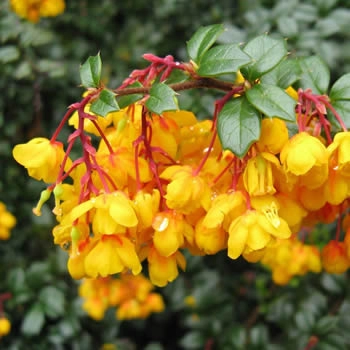
Pruning Shrubs
The Most Read Shrubs to Prune
- How to Prune Hydrangeas
- How to Prune a Rose Bush
- How to Prune Azaleas
- How to Prune a Lilac Bush
- How to Prune Buddleias - Butterfly Bushes
- How to Prune Forsythia
- How to Prune Weigela
- How to Prune Hebe
- How to Prune Camellia

Pruning Trees and Climbers
The Most Read Trees to Prune
- How to Prune Apple Trees
- Pruning Plum Trees
- Pruning Cherry Trees
- Pruning Olive Trees
- How to Prune a Grape Vine
- Acer Pruning | Pruning Japanese Maple
- How to Prune a Fig Tree
- Pruning Peach Trees
- Pruning Pear Trees
- How to Prune a Plum Tree

